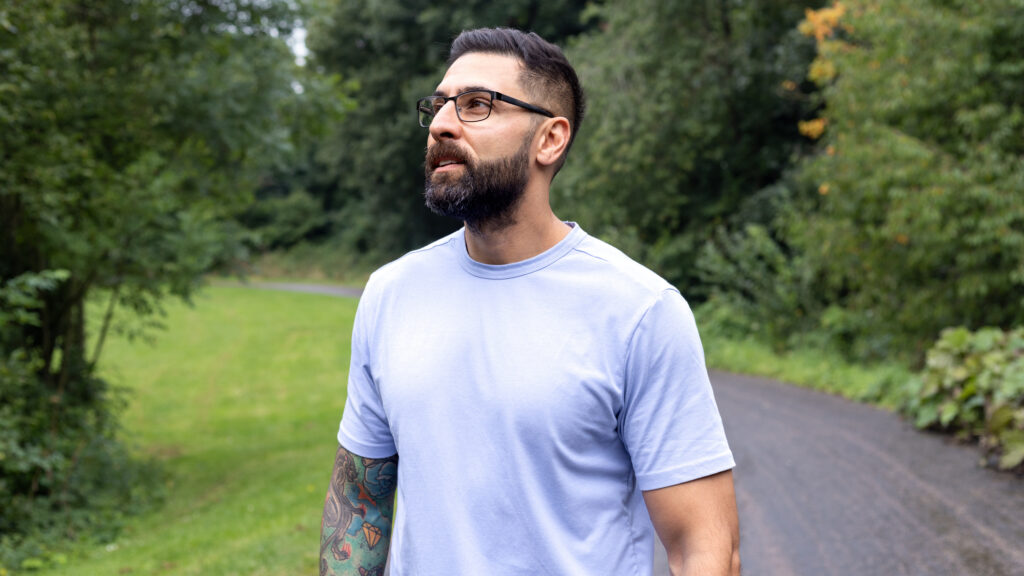
A medium shot of a thoughtful man strolling through a peaceful green park during a mental health walk. Surrounded by trees and natural light, he appears calm and reflective, promoting self-care, mindfulness, and emotional well-being in a serene outdoor setting. Videos are available similar to this scenario.
Mental health can be an unpredictable journey. One day you might feel on top of the world, and the next, it can seem like everything is falling apart. For many, including those living with generalized anxiety and panic disorders, managing these fluctuations is a daily challenge. Despite medication, mindfulness, and therapy, symptoms can sometimes resurface unexpectedly.
Recently, I found myself facing a resurgence of anxiety after a long period of stability. My symptoms are often physical—manifesting as pain, an upset stomach, and heart palpitations—alongside the typical racing thoughts and fear. Yet, life’s demands continue, and my dog still needs his daily walks. These walks are crucial for me, not just for exercise and bonding, but to combat any tendency towards agoraphobia.
In search of a new tool to help manage my anxiety, I stumbled upon the concept of color walking. This simple yet effective practice involves selecting a color and seeking it out during a walk, offering a mindful distraction from spiraling thoughts.
Understanding Color Walking
Color walking is a mindfulness exercise that encourages individuals to focus their attention on their surroundings by choosing a specific color to observe. This practice can be enhanced by taking photos of the color as you encounter it or simply making mental notes. The goal is to appreciate the color’s presence in the environment, reflecting on its shade, interaction with light, and texture.
Jaz Hand, a TikTok creator, has popularized this trend by demonstrating her own color walks, often focusing on vibrant colors like yellow. This practice not only engages the mind but also encourages a deeper connection with the environment.
The Impact of Color Walking on Mental Health
Having already explored walking yoga, I was eager to try a mindful practice that was less focused on physical sensations, given my pain levels. Inspired by colleagues who had tried color walking, I decided to give it a shot. I chose yellow, my favorite color, and embarked on a walk with my dog.
Providing Focus and Distraction
In moments of anxiety, my thoughts can spiral uncontrollably, often leading to panic attacks. Mindful practices like color walking help interrupt these thoughts, providing a focus that fills the mental space usually occupied by worry. During my walk, I found yellow in unexpected places: the centers of blue flowers, a woodpecker’s tail, even graffiti on a bin. This quest absorbed my attention, allowing me to set aside my anxiety temporarily.
“By the time I got home again, I was calmer, happier, and had achieved something. All big wins on a bad mental health day.”
Boosting Mood
Yellow has always been a mood-lifting color for me, reminiscent of sunflowers, bumblebees, and lemons. It’s also a herald of spring, appearing in daffodils and buttercups, and symbolizing the promise of sunshine and longer days. Seeking out yellow during my walks highlighted its abundance in the world, which helped elevate my mood despite underlying anxiety.
Managing Anxiety Without Medication
While medication is a necessary part of my anxiety management, relying on benzodiazepines for every outing is neither practical nor healthy. Instead, I began my color walks indoors, searching for yellow in my kitchen before venturing outside. This transition eased the overwhelming prospect of going out, reframing it as a simple quest for color rather than a daunting encounter with potential triggers.
“I relied on color walks over this challenging week until I began to feel more stable and will continue to do so on difficult days.”
Broader Implications and Future Outlook
The rise of color walking reflects a growing trend towards using mindful practices to manage mental health. Experts suggest that such techniques can complement traditional treatments, offering individuals additional tools to navigate their mental health journeys. As more people share their experiences with color walking, it may become a recognized strategy within mental health communities.
Looking ahead, the integration of simple, accessible practices like color walking into daily routines could provide significant benefits for those struggling with anxiety and other mental health challenges. As awareness grows, so too might the understanding and acceptance of diverse methods for mental health management.
In the meantime, for those facing similar struggles, color walking offers a tangible way to engage with the world, find joy in small details, and manage anxiety in a healthy, sustainable manner.





